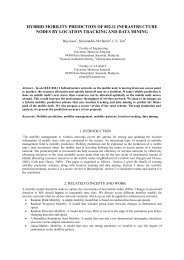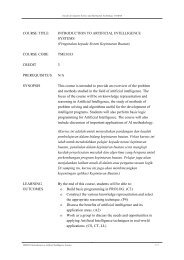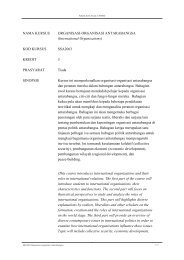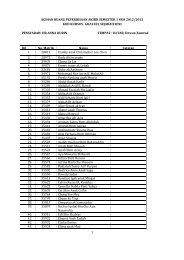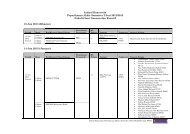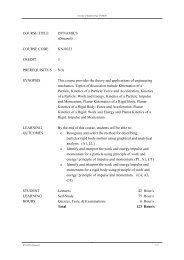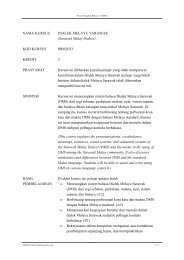COURSE TITLE ETHNOBOTANY (Etnobotani) COURSE CODE ...
COURSE TITLE ETHNOBOTANY (Etnobotani) COURSE CODE ...
COURSE TITLE ETHNOBOTANY (Etnobotani) COURSE CODE ...
You also want an ePaper? Increase the reach of your titles
YUMPU automatically turns print PDFs into web optimized ePapers that Google loves.
Faculty of Resource Science and Technology, UNIMAS<br />
<strong>COURSE</strong> <strong>TITLE</strong><br />
<strong>COURSE</strong> <strong>CODE</strong><br />
<strong>ETHNOBOTANY</strong><br />
(<strong>Etnobotani</strong>)<br />
STT3132<br />
CREDIT 2<br />
PREREQUISITE/S<br />
SYNOPSIS<br />
None<br />
This course focuses on the 5 main aspects in ethnobotany: its<br />
importance, botanical data collection<br />
methods,ethnopharmacology, economics importance of plants<br />
and the importance of ethnobotany in plant conservation.<br />
Selected species of plants will also be discussed as to give the<br />
students better insight of their importance. The course also<br />
include discussions on the future directions of ethnobotany.<br />
(Kursus ini akan menjelaskan 5 aspek dalam<br />
ethnobotani:kepentinganya, cara mengutip data<br />
botani,ethnopharmokarlogi,kepentingan ekonomik tumbuhan<br />
dan<br />
kepentingan enthnobotani dalam pemuliharaan. Kepentingan<br />
spesis tumbuhan tertentu akan dibincangankan secara<br />
terperinci. Perbincangan mengenai hala tuju ethnobotani turut<br />
dibincangkan.)<br />
LEARNING<br />
OUTCOMES<br />
By the end of this course, students will be able to:<br />
o To enhance the students knowledge about the importance<br />
and integrated approaches in ethnobotanical studies<br />
(C1, CS, CT)<br />
o Explain the various approaches in conducting<br />
ethnobotanical survey and research (C2, A3, CS, CT)<br />
o Appreciate the ethics of searching for new plant<br />
products,Analyze,distinguish the different types of<br />
photochemical analysis and screening<br />
- (C4, CS, CT)<br />
o Basic evaluation on the economics importance of plants<br />
(C4, CS, CT)<br />
o To inseminate awareness the importance of plant<br />
STT3132 Ethnobotany 1 / 4
Faculty of Resource Science and Technology, UNIMAS<br />
conservation (CS, CT, LL)<br />
STUDENT<br />
LEARNING<br />
HOURS<br />
Lectures<br />
Student-Centered Learning<br />
Self-Study<br />
Quizzes, Tests, & Examinations<br />
Total<br />
28 Hour/s<br />
4 Hour/s<br />
43 Hour/s<br />
5 Hour/s<br />
80 Hour/s<br />
LEARNING<br />
UNITS<br />
Supervised<br />
Learning Hours<br />
1. Definition and importance of ethnobotany, key<br />
concepts and challenges,<br />
2<br />
Integrated approaches in ethnobotanical research<br />
2. The important of local wealth and detailed<br />
information on plants.<br />
Selected disciplines which contribute to<br />
enthnobotanical studies.<br />
Case Studies of Ethnobotanical Research.<br />
2<br />
3. Methods of Botanical Collections<br />
2<br />
4. Rapid ethnobtanical appraisal<br />
2<br />
Ethnobotanical data - collections, identifying<br />
plants,preparation of ethnobotanical references<br />
5. Ethnobotanical research and community<br />
2<br />
development<br />
Documentation of plants useful to people<br />
6. EthnoPharmacology.<br />
2<br />
Systematic surveys of local plants.<br />
7. Bioprospecting. The ethics of searching for new plant 2<br />
products.<br />
Collecting plants for phytochemical analysis.<br />
8. Photochemical analysis and screening.<br />
2<br />
9. Economics and ethnobotany. The value of forest 2<br />
product and environment<br />
10. Economic and plant conservation.<br />
2<br />
STT3132 Ethnobotany 2 / 4
Faculty of Resource Science and Technology, UNIMAS<br />
11. Ethnobotany and Conservation<br />
2<br />
Disappearance of traditional knowledge.<br />
Local perspective on ethnobotanical research<br />
12. Conservation and development.<br />
Conservation legislation. The basis for<br />
legislation.Conservation law, the legal status of<br />
plant,collection control, trade control and habitat<br />
protection.<br />
2<br />
13. Currents treats to Biodiversity. Social forestry.<br />
Malaysia Biodiversity principles and habitat<br />
protection and strategies in conservation of<br />
endangered species<br />
2<br />
14. Future of Ethnobotany<br />
2<br />
Discussion on the future of Ethnobotany in Malaysia<br />
and South East Asia<br />
ASSESSMENT Group Assignments<br />
30 %<br />
Mid-Term Examination<br />
30 %<br />
Final Examination<br />
40 %<br />
Total<br />
100 %<br />
REFERENCES 1. Martin, G.J. 1995. Ethnobotany - A People and and Plants<br />
Conservation Manual. Chapman, London.<br />
2. Ahmad F. and K. Mat-Salleh.1988. Penyaringan fitokimia<br />
tumbuh-tumbuhan Sabah. In: E. Soepadmo, S.H.<br />
Goh,W.H.Wong, L.B. Din and C.H. Chuah (Eds.).<br />
Proceedings of the Seminar on Malaysian Traditional<br />
Medicine,147-158, Kuala Lumpur.<br />
3. Said I.M., L.B. Din, M.W. Samsudin, Z. Zakaria,<br />
N.I.Yusoff, U. Suki, A. Manaf, A.Z.Ibrahim and A.<br />
Latiff.1990. A phytochernical survey of Uku Kincin,<br />
Pahang,Malaysia. Mal. Nat. .J. 43: 260-266.<br />
4. Wan-Yaacob A., S.W. Tong, L.B. Din, Y.N.I. Yusoff,<br />
A.Lafiff and K. Mat Salleh. 2000. An alkaloid<br />
STT3132 Ethnobotany 3 / 4
Faculty of Resource Science and Technology, UNIMAS<br />
phytochemical survey of plants in the Gunung Danum<br />
area,Sabah,Malaysia. Mal. Nat. J. 54 (2): 87-94.<br />
5. Said I.M., L.B. Din, M.W. Samsudin, N.I. Yusoff,<br />
A.Latiff, R. Mat-Ali and A.H.A. Hadi.1995. A<br />
phytochernical survey of Sayap-Kinabalu Park, Sabah.<br />
In:G. Ismail B. Din (Eds.). A Scientific Journey Through<br />
Borneo, Sayap Kinabalu Park, Sabah. 137-144. Pelanduk<br />
Publications.<br />
Last updated: May 23, 2011, Mon, 4:57 PM<br />
STT3132 Ethnobotany 4 / 4




